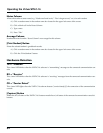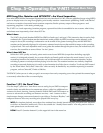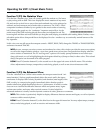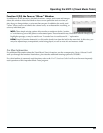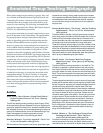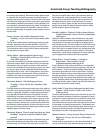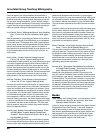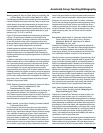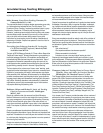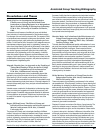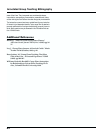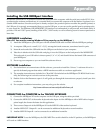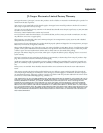
Bastien, James W. How to Teach Piano Successfully, 3rd
ed. San Diego, CA: Neil A. Kjos Music Co., 1995.
This pedagogy text presents what is perhaps the most comprehensive
information available about group piano study. Taken into account are
multiple levels of group study, issues pertaining to the group environ-
ment and student involvement, and examples illustrating the many
points made by Bastien. A few chapters in particular focus on the group
process. The pages that are the most valuable references for group
teachers are pp. 15-16, 30-31, and 82-94.
Pages 15-16 list some considerations for those wanting to teach piano
in groups. The questions are intended to provoke thought for the
potential group teacher. The teacher is queried as to his or her desire
to work with groups of children, ability to organize activities, skill in
developing interest in group learning, and belief that students will learn
as much in a group setting as they would in private study.
Scheduling issues are explored on pages 30-31. Combination group
and private lessons as well as small and large group lessons are
explored as viable options in the independent studio. Sample grids
illustrate hypothetical time and space arrangements for the studio offer-
ing group lessons.
In addition to information on class size, group activities and equipment,
Bastien includes a section on music readiness, and invites considera-
tion of yet another possible group class in the piano studio. General
music concepts such as the musical alphabet, rhythm, and high and
low may be taught prior to serious concentration on the physical
aspects specific to piano playing. With this solid foundation of musical
knowledge, students may progress more quickly through the beginning
stages of piano study. In addition, exposure to the group setting in the
form of a music readiness class aids in the adaptation of a student to a
group class in piano. Photographs illustrate the activities and use of
equipment in a group piano studio.
Clark, Frances. Questions and Answers: Practical Advice
for Piano Teachers. Northfield, IL: The
Instrumentalist Co., 1992.
Clark addresses the subject of teaching methods in her well-known for-
mat of questions and answers in this noteworthy book (pages 183-
190). Questions posed by teachers range from the topic of group study
versus private to discussion of disruptive students in a class setting to
repertoire classes as a supplement for private piano lessons.
Enoch, Yvonne. Group Piano Teaching. London: Oxford
University Press, 1974.
Enoch’s chapter on planning the piano group covers the reasoning
behind group teaching, the number of pianos and students that are
ideal in a group, the number and length of lessons, classroom arrange-
ment, preparation for teaching group piano, and the importance of
parental reports. Another chapter that may prove inspirational to the
group piano teacher is chapter eight, in which the author offers hints
and information to other teachers. This checklist is worth reading fre-
quently, because it contains a number of items for teachers to remem-
ber or consider in group teaching. Many of these items are second
nature to the group teacher, but others may need constant notice and
work in order to become incorporated in the techniques of the teacher.
Some parts of this book are rather dated. For instance, a disclaimer
from the author at the beginning states that she stopped using dummy
keyboards since first printing of the book, even though they are pro-
moted as a good teaching tool in the text. Also, chapters covering con-
tent of the first lesson, first term, first year and beyond focus on one
specific sequencing, which may not coincide with other teachers’
philosophies.
Kowalchyk, Gayle and E. L. Lancaster. Alfred’s Basic
Piano Library: Group Piano Course, Teacher’s
Handbook, Books 1-2. Van Nuys, CA: Alfred
Publishing Co., Inc., 1997.
Kowalchyk and Lancaster provide a course specifically designed for
group piano instruction. To be noted here is the eight-page supplement
in the front of the teacher handbook aimed at dealing with practical
issues of group teaching. This same supplement may be found in the
front of the teacher handbook to books 3-4 of this series as well.
General information concerning advantages of group teaching (a list of
sixteen items), types of groups, equipment needs for large and small
groups, the process of grouping students, and scheduling lessons is
useful to the independent teacher. Teachers may find the lesson plan-
ning segment especially valuable due to its focus on organizing the
lesson, classroom management, effective teaching techniques and
effective use of technology. The classroom management portion, in
particular, emphasizes suggestions for the teacher including the impor-
tance of eye contact, benefits of specific feedback, proper balance of
talking and playing, inclusion of every student, use of humor, and the
need for variety in student tasks. Effective teaching techniques applica-
ble to specific areas like new concepts, ear training, technique, rhythm
drills, composition and improvisation, sight reading, and ensemble
work direct the teacher’s focus in appropriate and creative ways.
Lyke, James, Yvonne Enoch, and Geoffrey Haydon.
Creative Piano Teaching, 3rd ed. Champaign, IL:
Stipes Publishing Co., 1996.
Chapter four of Creative Piano Teaching is an essay by James Lyke
addressing the issue of private, group, or a combination of both in
piano study. Common falsehoods discouraging teachers from teaching
in groups such as lack of equipment and emphasis on keyboard skills
above performance are addressed and explained. Basic equipment for
group teaching is listed in the chapter, and independent teachers may
be surprised at the uncomplicated setting in which group piano may be
taught effectively. Lyke’s list of essentials for a working group teaching
situation is worth study by the teacher. Grouping, teaching without
“telling,” and modeling are among the items isolated by the author as
necessities for a well-run group piano class.
The combination approach to piano teaching where private lessons are
supplemented with musicianship classes is given consideration as well.
Specific guidelines for planning lessons with proper sequencing and
content are precise yet helpful to the group teacher. A sample pre-print-
Annotated Group Teaching Bibliography
39




